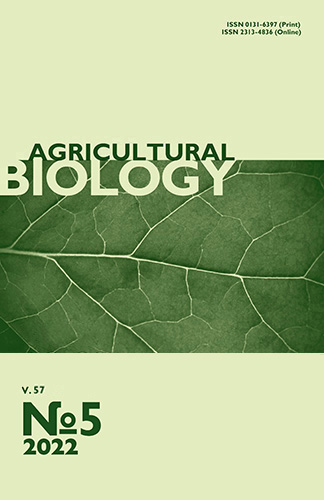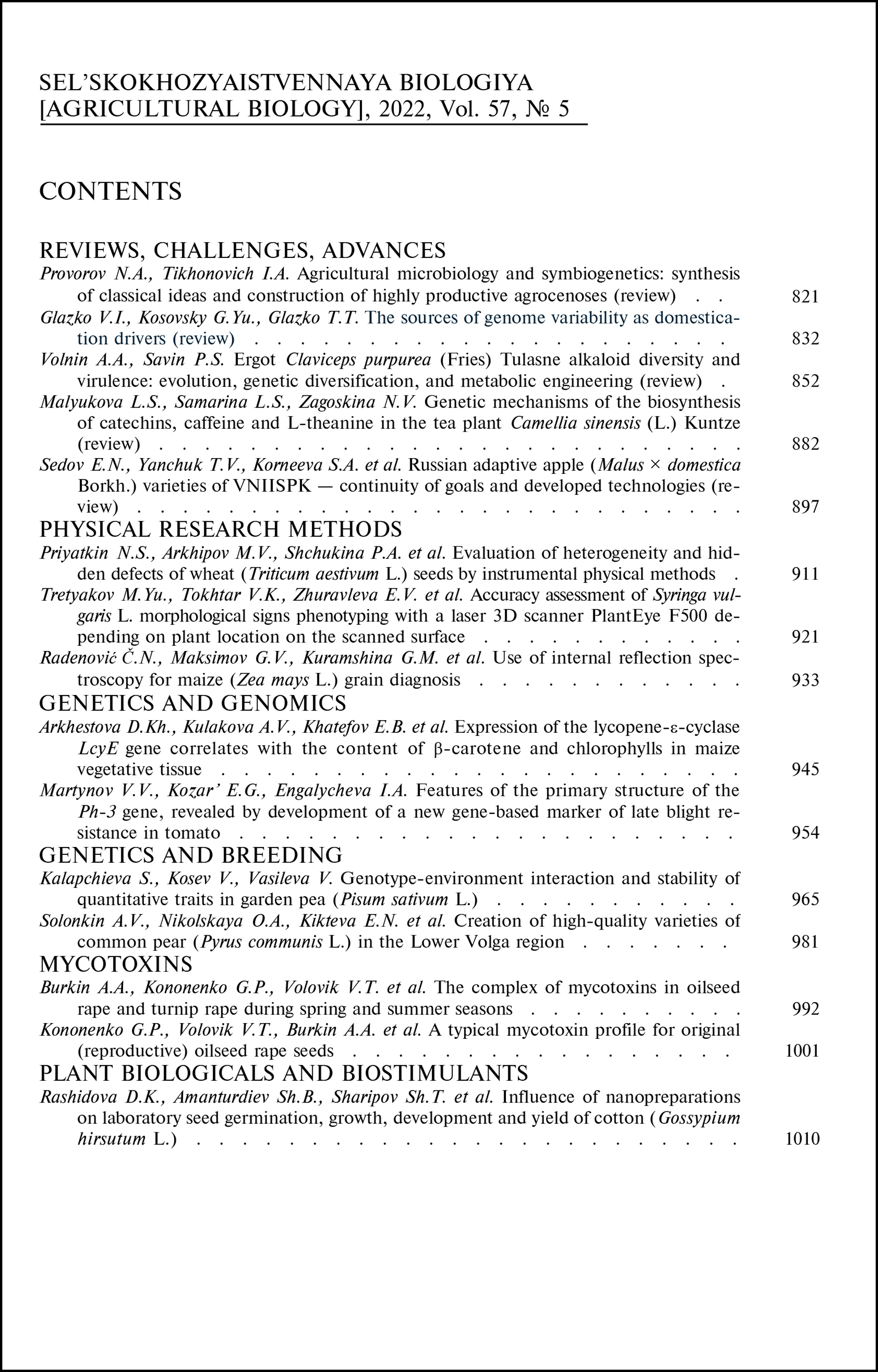doi: 10.15389/agrobiology.2022.5.921eng
UDC: 631.524.5:57.084.1
Acknowledgements:
Supported financially from the Ministry of Science and Higher Education of the Russian Federation (grant No. FZWG-2021-0018 as part of the state assignment)
ACCURACY ASSESSMENT OF Syringa vulgaris L. MORPHOLOGICAL SIGNS PHENOTYPING WITH A LASER 3D SCANNER PlantEye F500 DEPENDING ON PLANT LOCATION ON THE SCANNED SURFACE
M.Yu. Tretyakov1 ✉, V.K. Tokhtar1, E.V. Zhuravleva2, D.V. Biryukov1
1Belgorod State National Research University, REC Botanical Garden NRU BelSU, 85 ul. Pobedy Belgorod, 308015 Russia, e-mail tretyakovmiy@gmail.com (✉ corresponding author), tokhtar@bsu.edu.ru, biryukov@bsu.edu.ru;2EFKO Group of Companies, 4 ul. Frunze, Alekseevka, Belgorod Province, 309850 Russia, e-mail zhuravla@yandex.ru
ORCID:
Tretyakov M.Yu. orcid.org/0000-0001-6789-8060
Zhuravleva E.K. orcid.org/0000-0002-3253-0730
Tokhtar V.K. orcid.org/0000-0002-7417-4893
Biryukov D.V. orcid.org/0000-0001-9336-2278
Received May 11, 2022
Since the methodological methods of direct genetics are applicable only for monogenic traits, the created breeding material, line or variety must be tested in the field, since the presence of the desired gene in the genome, confirmed by molecular methods, does not always lead to the formation of a trait valuable for selection. Systems based on 3D imaging technologies make it possible to obtain a plant model, as well as information on morphological parameters. However, very little attention is paid to the preparation of protocols for phenoscreening. The purpose of this study was a comparative assessment of the accuracy of determining the morphological characteristics of lilac plants by traditional methods and using machine vision technology, depending on the plant location on the scanned surface. Microclones of lilac (Syringa vulgaris L.) cv. Microclones are morphologically homogenous and small in size, which allows measurements of sufficiently large sets of samples and makes it easier to compare the research results by their normalization to average values. The measurements were made after the plant complete adaptation and cultivation for 1 month in a greenhouse. With traditional morphometry, in 10 microclones, the height was measured with a measuring ruler, and the leaf area was measured using the contour method. When scanning (PlantEye F500 3D scanner, Phenospex B.V., Netherlands), each of 10 selected plants was placed at five different positions of the scanned surface, and at least five repeated scans were performed in the same position. When using machine vision technology, 3D leaf area, projected leaf area, digital biomass, height, maximum height, leaf tilt, leaf tilt angle, light penetration depth were determined. It has been established that in order to obtain objective and comparable data from using a 3D scanner, it is optimal to place plants in the center of the scanned surface in the same position. The following parameters can be recommended to identify varieties and assess plant growth rate: the leaf area, projected leaf area, height, and leaf inclination angle. For each plant species, it is necessary to preliminarily study particular morphological traits and to compare the obtained data with the scan results in order to introduce correction factors/ This will confirm the information content of the feature set used, thereby increasing the accuracy of machine vision technology data.
Keywords: phenotyping, morphology, Syringa vulgaris L., machine vision technology, 3D canning.
REFERENCES
- Kumar J., Rai K.M. Research advances in plant genomics. All Life, 2021, 11: 1313 CrossRef
- Bennett M.D., Leitch I.J. Plant genome size research: a field in focus. Annals of Botany, 2005, 95(1): 1-6 CrossRef
- Genaev M.A., Shmakov N.A., Mustafin Z.S., Mukhin A.M., Konstantinov D.K., Doroshkov A.V., Lashin S.A., Afonnikov D.A. VII S»ezd Vavilovskogo obshchestva genetikov i selektsionerov, posvyashchennyy 100-letiyu kafedry genetiki SPbGU, i assotsiirovannye simpoziumy. Sbornik tezisov Mezhdunarodnogo Kongressa [VII Congress of the Vavilov Society of Geneticists and Breeders, dedicated to the 100th anniversary of the Department of Genetics of St. Petersburg State University, and associated symposiums. Collection of abstracts of the International Congress]. St. Petersburg, 2019: 528 (in Russ.).
- Kir’yanova O.Yu., Kuluev B.R., Kuluev A.R., Mardanshin I.S., Gubaydullin I.M., Chemeris A.V. Biomika, 2020, 12(2): 194-210 CrossRef (in Russ.).
- D’yachenko E.A., Kulakova A.V., Kochieva E.Z., Shchennikova A.V. Variability of genomic RGA-loci of modern russian potato cultivars: NBS-profiling data. Sel'skokhozyaistvennaya biologiya [Agricultural Biology], 2021, 56(1): 32-43 CrossRef
- Ponomareva M.L., Ponomarev S.N., Tagirov M.Sh., Gil’mullina L.F., Mannapova G.S. Pentosan content genotypic variability in winter rye grain. Sel'skokhozyaistvennaya biologiya [Agricultural Biology], 2017, 52(5): 1041-1048 CrossRef
- Rogozina E.V., Terent’eva E.V., Potokina E.K., Yurkina E.N., Nikulin A.V., Alekseev Ya.I. Multiplex PCR-based identification of potato genotypes as donors in breeding for resistance to diseases and pests. Sel'skokhozyaistvennayabiologiya[AgriculturalBiology], 2019, 54(1): 19-30 CrossRef
- Nakanwagi M.J., Sseremba G., Kabod N.P., Masanza M., Kizito E.B. Identification of growth stage-specific watering thresholds for drought screening in Solanum aethiopicum Shum. Scientific Reports, 2020, 10: 862 CrossRef
- Robles P., Quesada V. Organelle genetics in plants. International Journal of Molecular Science, 2021, 22(4): 2104 CrossRef
- Heslop-Harrison J.S.P., Schwarzacher T. Organisation of the plant genome in chromosomes. The Plant Journal, 2011. 66(1): 18-33 CrossRef
- Belonogova N.M. Vavilovskiy zhurnal genetiki i selektsii, 2014, 18(1): 147-157 (in Russ.).
- Endalkachew A. Review on forward and reverse genetics in plant breeding. All Life, 2021, 14(1): 127-135 CrossRef
- Gilchrist E., Haughn G. Reverse genetics techniques: engineering loss and gain of gene function in plants. Briefings in Functional Genomics, 2010, 9(2): 103-110 CrossRef
- Lyu J. Reverse genetics: wheat solution. Nature Plants, 2017, 3: 17005 CrossRef
- Holubová K., Hensel G., Vojta P., Tarkowski P., Bergougnoux V., Galuszka P. Modification of Barley plant productivity through regulation of cytokinin content by reverse-genetics approaches. Frontiers in Plant Science, 2018, 27(9): 1676 CrossRef
- Novokhatin V.V., Dragavtsev V.A., Leonova T.A., Shelomentseva T.V. Creation of a spring soft wheat variety Grenada with the use of innovative breeding technologies based on the original theory of eco-genetic arrangement of quantitative traits. Sel'skokhozyaistvennaya biologiya [Agricultural Biology], 2019, 54(5): 905-919 CrossRef
- Crossa J., Fritsche-Neto R., Montesinos-Lopez Osval A., Costa-Neto G., Dreisigacker S., Montesinos-Lopez A., Bentley Alison R. The modern plant breeding triangle: optimizing the use of gGenomics, phenomics, and enviromics data. Frontiers in Plant Science, 2021, 12: 651480 CrossRef
- Khlestkina E.K., Khlestkin V.K. Materialy mezhdunarodnoy nauchno-prakticheskoy konferentsii «Kartofelevodstvo» [Proc. Int. Conf. «Potato growing»]. Moscow, 2017: 59-64 (in Russ.).
- Tokhtar’ V.K., Mazur N.V. Nauchnye vedomosti Belgorodskogo gosudarstvennogo universiteta. Seriya: Estestvennye nauki, 2011, 15/1(104): 249-253 (in Russ.).
- Furbank R.T., Tester M. Phenomics — technologies to relieve the phenotyping bottleneck. Trends in Plant Science, 2011, 16(12): 635-644 CrossRef
- Li L., Zhang Q., Huang D. A review of imaging techniques for plant phenotyping. Sensors, 2014, 14(11): 20078-20111 CrossRef
- Afonnikov D.A., Genaev M.A., Doroshkov A.V., Komyshev E. G., Pshenichnikova T.A. Genetika, 2016, 52(7): 788-803 CrossRef (in Russ.).
- Seregin A.P., Bochkov D.A., Shner Yu.V., Garin Е.V., Mayorov S.R., Golyakov P.V., Bol’shakov B.V., Prokhorov V.E., Mallaliev M.M., Vinogradov G.M., Еbel’ A.L., Kashirina E.S., Biryukova O.V., Kuryakova O.P., Mirvoda S.V., Khimin A.N., Murtazaliev R.A., Zelenkova V.N., Dudov S.V., Gorbunova M.S. i dr. Zhurnal obshchey biologii, 2020, 81(3): 223-233 CrossRef (in Russ.).
- Svetasheva T.Yu., Lakomov A.F., Privalova M.V., Smirnova E.V., Maksimova T.V. Fitoraznoobrazie Vostochnoy Evropy, 2020, 14(4): 549-559 CrossRef (in Russ.).
- Liu H., Bruning B., Garnett T., Berger B. Hyperspectral imaging and 3D technologies for plant phenotyping: From satellite to close-range sensing. Computers and Electronics in Agriculture, 2020, 175: 105621 CrossRef
- Reeb R.A., Aziz N., Lapp S.M., Kitzes J., Heberling J.M., Kuebbing S.E. Using convolutional neural networks to efficiently extract immense phenological data from community science images. Frontiers in Plant Science, 2022, 12: 787407 CrossRef
- Gibbs J.A., Pound M., French A.P., Wells D.M., Murchie E., Pridmore T. Plant phenotyping: an active vision cell for three-dimensional plant shoot reconstruction. Plant Physiology, 2018, 178(2): 524-534 CrossRef
- Tomé F., Jansseune K., Saey B., Grundy J., Vandenbroucke K., Hannah M.A., Redestig H. rosettR: protocol and software for seedling area and growth analysis. Plant Methods, 2017, 13: 13 CrossRef
- Tsaftaris S.A., Minervini M., Scharr H. Machine learning for plant phenotyping needs image processing. Trends in Plant Science, 2016, 21(12): 989-991 CrossRef
- Ubbens J.R., Stavness I. Deep plant phenomics: a deep learning platform for complex plant phenotyping tasks. Frontiers in Plant Science, 2017, 8: 1190 CrossRef
- Coppens F., Wuyts N., Inzé D., Dhondt S. Unlocking the potential of plant phenotyping data through integration and data-driven approaches. Current Opinion in Systems Biology, 2017, 4: 58-63 CrossRef
- Fasoula D.A., Ioannides I.M., Omirou M. Phenotyping and plant breeding: overcoming the barriers. Frontiers in Plant Science, 2020, 10: 1713 CrossRef
- Carvalho L.C., Gonçalves E.F., da Silva J.M., Miguel J. Potential phenotyping methodologies to assess inter- and intravarietal variability and to select grapevine genotypes tolerant to abiotic stress. Frontiers in Plant Science, 2021, 12: 71820226 CrossRef
- Naik H.S., Zhang J., Lofquist A., Assefa T., Sarkar S., Ackerman D., Singh A., Singh A.K., Ganapathysubramanian B. A real-time phenotyping framework using machine learning for plant stress severity rating in soybean. Plant Methods, 2017, 13: 23 CrossRef
- Wang Y., Wen W., Wu S., Wang C., Yu Z., Guo X., Zhao C. Maize plant phenotyping: comparing 3D laser scanning, multi-view stereo reconstruction, and 3D digitizing estimates. Remote Sensing, 2018, 11(1): 63 CrossRef
- Aleynikov Y.G., Konstantinovich A.V. Creation of 3D cloud models for plants using a scanner and walking machine with dynamic stability. Bioscience Biotechnology Research Communications, 2021, 14(2): 505-508 CrossRef
- Paulus S. Measuring crops in 3D: using geometry for plant phenotyping. Plant Methods, 2019, 15: 103 CrossRef
- Yang W., Guo Z., Huang C., Duan L., Chen G., Jiang N., Fang W., Feng H., Xie W., Lian X., Wang G., Luo Q., Zhang Q., Liu Q., Xiong L. Combining high-throughput phenotyping and genome-wide association studies to reveal natural genetic variation in rice. Nature Communications, 2014. 5: 5087 CrossRef
- Klukas C., Chen D., Pape J.M. Integrated analysis platform: an open-source information system for highthroughput plant phenotyping. Plant Physiology, 2014, 165(2): 506-518 CrossRef
- Chen D., Neumann K., Friedel S., Kilian B., Chen M., Altmann T., Klukas C. Dissecting the phenotypic components of crop plant growth and drought responses based on high-throughput image analysis. The Plant Cell, 2014, 26(12): 4636-4655 CrossRef
- Bondarenko V.Yu., Barkovskiy A.V., Shashko A.Yu., Chernysh M.A., Przheval’skaya D.A., Kolbanov D.V., Sokolik A.I., Smolich I.I., Medvedev S.S., Demidchik V.V. Zhurnal Belorusskogo gosudarstvennogo universiteta. Biologiya, 2019, 1: 25-32 CrossRef (in Russ.).












